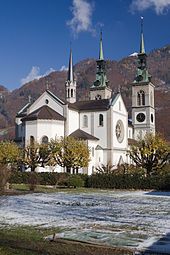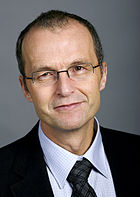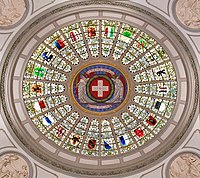Glarus
Glarus | |
|---|---|
 | |
Wiesbaden-Biebrich (Germany) | |
| Website | www SFSO statistics |
Glarus (German:
Glarus lies on the river
History


Glarus is first mentioned in the early 9th century in Latin as Clarona. In 1178 it was first mentioned in German as Glarus.[4]
On 10 February 878, the Emperor Charles the Fat gave his wife Richgard or Richardis the monasteries of Säckingen, of St. Felix and of Regula in Zürich as a royal estate. This land grant included extensive political rights and a large estate. This estate covered land in the Rhine and Frick valleys, the southern Hotzenwald, land in Zürich, along Lake Walen and the valley of Glarus. Glarus remained under the Säckingen Abbey until 1395 (intermittently under the overlordship of either the
It became the capital of the Linth valley in 1419. In the 18th and 19th centuries, the valley began to be industrialized.
In 1528 the Reformation gained a foothold in Glarus, directed by Zwingli in Zürich. Even though he had preached in Glarus for 10 years, the town remained strongly Catholic. However, following the
Following the French invasion in 1798, Glarus became the capital of the Canton of Linth in the Helvetic Republic. The administration of the Canton moved into Glarus. However, the new administrators had difficulties in establishing and enforcing any new regulations. In August 1802 the administrators of the new Canton left Glarus for Rapperswil due to the difficulties they had faced in Glarus. In 1803, with the Act of Mediation, the Canton of Linth was dissolved and Glarus became the capital of the smaller Canton of Glarus.[8]
In 1859, the railway reached Glarus from Weesen. The extension to Schwanden and Linthal opened in 1879.[9]
The town created the Emigration Society and sent Judge Niklaus Dürst and blacksmith Fridolin Streif to search for land to settle in North America in 1845. Later that year, 131 colonists from Glarus settled New Glarus, Wisconsin, a town which still holds onto its Swiss roots and enjoys a strong relationship with Glarus.[10]
On the 10/11 May 1861, the town was devastated by a fire that was fanned by a violent
In 1864, the first European labor law to protect workers was introduced in Glarus, prohibiting workers from working more than 12 hours a day.[citation needed]
Geography


The town is located in the Glarner Mittelland on a broad valley floor between the Glärnisch and the Linth.
The municipality Glarus before 2011 had an area of 69.2 km2 (26.7 sq mi). Of this area, 23% was used for agricultural purposes, while 31.4% was forested; of the rest of the land, 2.7% was settled (buildings or roads) and the remainder (42.9%) was non-productive (2006 figures).[12]
With the incorporation of Ennenda, Netstal and Riedern in 2011, the municipality Glarus now has an area of 103.67 km2 (40.03 sq mi).[13] Based on the 2004/09 survey, about 26.3% of the total area is used for agricultural purposes, while 34.3% is forested. Of the rest of the land, 4.1% is settled (buildings or roads) and 35.2% is unproductive land. Over the past two decades (1979/85-2004/09) the amount of land that is settled has increased by 42 ha (100 acres) and the agricultural land has decreased by 60 ha (150 acres).[14]
Demographics
Glarus has a population (as of December 2020[update]) of 12,539.
As of 2013[update], children and teenagers (0–19 years old) make up 20.6% of the population, while adults (20–64 years old) are 61.1% and seniors (over 64 years old) make up 18.3%.[14]
Most of the population (as of 2000[update]) speaks German (86.0%), with Italian being second most common (4.8%) and Albanian being third (2.6%).[12]
Historical population
The historical population is given in the following table:[4]
| year | population | Swiss Citizens | % German Speaking | % Protestant | % Roman Catholic |
|---|---|---|---|---|---|
| 1554 | ca. 1,550 | ||||
| 1682 | ca. 1,200 | ||||
| 1777 | ca. 2,400 | ||||
| 1837 | 4,094 | ||||
| 1850 | 4,082 | 3,960 | 86.0% | 14.0% | |
| 1870 | 5,485 | 5,204 | 77.7% | 22.6% | |
| 1888 | 5,357 | 4,968 | 98.1% | 71.6% | 28.0% |
| 1900 | 4,877 | 4,424 | 97.5% | 74.2% | 25.6% |
| 1910 | 5,123 | 4,471 | 94.8% | 70.8% | 28.7% |
| 1930 | 5,269 | 4,858 | 97.7% | 70.5% | 29.2% |
| 1950 | 5,724 | 5,376 | 96.2% | 68.0% | 31.4% |
| 1970 | 6,189 | 5,215 | 86.9% | 60.5% | 38.9% |
| 1990 | 5,728 | 4,723 | 86.1% | 51.9% | 42.4% |
| 2000 | 5,556 | 4,379 | 86.0% | 45.4% | 37.7% |
Economy
As of 2012[update], there were a total of 8,148 people employed in the municipality. Of these, a total of 175 people worked in 63 businesses in the primary economic sector. The secondary sector employed 2,479 workers in 200 separate businesses. Finally, the tertiary sector provided 5,494 jobs in 923 businesses. In 2013 a total of 2.% of the population received social assistance.[14]
Politics
In the 2015 federal election the most popular party was the BDP with 49.7% of the vote, followed by the SP with 47.7%. The remaining 2.6% went to unaffiliated or minor party candidates. In the federal election, a total of 3,250 votes were cast, and the voter turnout was 41.1%. The 2015 election saw a large change in the voting when compared to 2011. The percentage of the vote received by the SP increased sharply from 28.9% in 2011 to 47.7% in 2015, while the percentage that the BDP dropped from 57.7% to 49.7%.[16]
Crime
In 2014 the crime rate, of the over 200 crimes listed in the
Education
In Glarus about 71.3% of the population (between age 25–64) have completed either non-mandatory upper secondary education or additional higher education (either university or a Fachhochschule).[12]
Transport
Climate
Between 1991 and 2020 Glarus had an average of 142.2 days of rain per year and on average received 1,494 mm (58.8 in) of
| Climate data for Glarus (517m a.s.l., reference period 1991–2020) | |||||||||||||
|---|---|---|---|---|---|---|---|---|---|---|---|---|---|
| Month | Jan | Feb | Mar | Apr | May | Jun | Jul | Aug | Sep | Oct | Nov | Dec | Year |
| Mean daily maximum °C (°F) | 3.2 (37.8) |
4.8 (40.6) |
9.9 (49.8) |
14.8 (58.6) |
19.0 (66.2) |
22.2 (72.0) |
23.8 (74.8) |
23.2 (73.8) |
18.6 (65.5) |
14.1 (57.4) |
8.1 (46.6) |
3.9 (39.0) |
13.8 (56.8) |
| Daily mean °C (°F) | 0.0 (32.0) |
1.0 (33.8) |
5.2 (41.4) |
9.5 (49.1) |
13.5 (56.3) |
16.7 (62.1) |
18.3 (64.9) |
17.9 (64.2) |
14.0 (57.2) |
9.8 (49.6) |
4.6 (40.3) |
0.9 (33.6) |
9.3 (48.7) |
| Mean daily minimum °C (°F) | −3.0 (26.6) |
−2.4 (27.7) |
1.0 (33.8) |
4.4 (39.9) |
8.4 (47.1) |
11.9 (53.4) |
13.6 (56.5) |
13.5 (56.3) |
10.0 (50.0) |
6.1 (43.0) |
1.5 (34.7) |
−1.9 (28.6) |
5.3 (41.5) |
| Average precipitation mm (inches) | 92 (3.6) |
80 (3.1) |
99 (3.9) |
93 (3.7) |
132 (5.2) |
167 (6.6) |
193 (7.6) |
192 (7.6) |
131 (5.2) |
104 (4.1) |
101 (4.0) |
110 (4.3) |
1,494 (58.8) |
| Average snowfall cm (inches) | 32.7 (12.9) |
29.9 (11.8) |
14.4 (5.7) |
0.5 (0.2) |
0.0 (0.0) |
0.0 (0.0) |
0.0 (0.0) |
0.0 (0.0) |
0.0 (0.0) |
0.7 (0.3) |
10.9 (4.3) |
31.5 (12.4) |
120.6 (47.5) |
| Average precipitation days (≥ 1.0 mm) | 10.7 | 9.5 | 11.3 | 11.2 | 13.5 | 14.3 | 14.8 | 14.3 | 11.6 | 10.0 | 10.2 | 10.8 | 142.2 |
| Average snowy days (≥ 1.0 cm) | 5.7 | 4.9 | 3.7 | 0.3 | 0.0 | 0.0 | 0.0 | 0.0 | 0.0 | 0.1 | 1.8 | 5.1 | 21.6 |
| Average relative humidity (%)
|
82 | 77 | 72 | 67 | 71 | 74 | 76 | 78 | 81 | 82 | 82 | 83 | 77 |
| Mean monthly sunshine hours | 62 | 71 | 96 | 137 | 156 | 164 | 175 | 163 | 109 | 86 | 60 | 54 | 1,331 |
| Percent possible sunshine | 44 | 48 | 50 | 49 | 45 | 46 | 49 | 51 | 53 | 50 | 42 | 39 | 48 |
| Source: MeteoSwiss (snow 1981–2010)[21][22] | |||||||||||||
Gallery
-
Town center of Glarus
-
Kantonsparlement
-
Landsgemeindeplatz
-
Glärnisch
-
Glarus railway station
International relations
Twin towns – Sister cities
Glarus is
- Wiesbaden-Biebrich[24]
 New Glarus, Wisconsin[24]
New Glarus, Wisconsin[24]
Notable people



- Anna Göldi (1734 – 1782 in Glarus) the last person to be executed in Europe for witchcraft
- Heinrich Hössli (1784 in Glarus – 1864 in Winterthur) a Swiss hatter and author
- Johann Jakob von Tschudi (1818 in Glarus – 1889) a Swiss naturalist, explorer and diplomat
- Johann Jakob Blumer (1819 in Glarus – 1875) a Swiss statesman[25]
- Franz Joseph Untersee (1858 in Glarus - 1927) a Swiss-American architect who designed many Roman Catholic churches in the US
- Roslï Näf (1911 in Glarus – 1996) a Swiss Red Cross nurse during the Holocaust
- Rudi Schmid (1922 in Glarus – 2007) an American medical researcher specializing in hepatology
- Bernhard Hoesli (1923 in Glarus – 1984) a Swiss architect and collage artist
- Erwin C. Dietrich (1930 in Glarus – 2018) film director, producer, actor and cinematographers[26]
- Eveline Hasler (born 1933 in Glarus) a Swiss writer
- Marianne Horak (born 1944 in Glarus) a Swiss-Australian entomologist who specialises in Australian lepidoptera
- Giaco Schiesser (born 1953 in Glarus) professor for cultural theory and media theory at Zurich University of the Arts
- Werner Marti (born 1957 in Glarus) a Swiss lawyer and politician
- Ruedi Noser (born 1961 in Glarus) a Swiss businessman and politician
- Tim Krohn (born 1965) an author of Swiss literature, grew up in Glarus
Sport
- Paul Fischli (born 1945 in Glarus) a Swiss former football player and manager
- Fritz Künzli (1946 in Glarus – 2019) a retired Swiss football striker.
- Ekkehard Fasser (1952 in Glarus – 2021) a bobsledder who competed in the 1988 Winter Olympics
- René Botteron (born 1954 in Glarus) a Swiss former football midfielder, over 330 club caps
- Urs Sonderegger (born 1964 in Glarus) a Swiss entrepreneur and racing driver
- Valeria Spälty (born 1983 in Glarus) a Swiss curler, silver medallist at the 2006 Winter Olympics
- Jan Hauser (born 1985 in Glarus) a Swiss curler, competed in the 2010 Winter Olympics
- Colin Stüssi (born 1993 in Glarus) a Swiss cyclist
References
- ^ a b "Arealstatistik Standard - Gemeinden nach 4 Hauptbereichen". Federal Statistical Office. Retrieved 13 January 2019.
- ^ "Ständige Wohnbevölkerung nach Staatsangehörigkeitskategorie Geschlecht und Gemeinde; Provisorische Jahresergebnisse; 2018". Federal Statistical Office. 9 April 2019. Retrieved 11 April 2019.
- ^ Amtliches Gemeindeverzeichnis der Schweiz published by the Swiss Federal Statistical Office (in German) accessed 18 February 2011
- ^ a b Glarus in German, French and Italian in the online Historical Dictionary of Switzerland.
- ^ Lothar Deplazes: Raetia Curiensis in German, French and Italian in the online Historical Dictionary of Switzerland.
- ^ Säckingen in German, French and Italian in the online Historical Dictionary of Switzerland.
- ^ Glarus from the High Middle Ages until the 18th Century-Churches in German, French and Italian in the online Historical Dictionary of Switzerland.
- ^ Glarus in the 19. and 20. Centuries-Political and administrative development in German, French and Italian in the online Historical Dictionary of Switzerland.
- ^ "Güterschuppen 8750 Glarus" (in German). Schweizer Heimatschutz.ch. Archived from the original on 30 December 2013. Retrieved 22 May 2013.
- ^ "New Glarus History/Timeline". New Glarus Historical Society. Retrieved 28 July 2021.
- ^ Chisholm, Hugh, ed. (1911). . Encyclopædia Britannica (11th ed.). Cambridge University Press.
- ^ a b c Swiss Federal Statistical Office Archived 5 January 2016 at the Wayback Machine accessed 10-Sep-2009
- ^ Arealstatistik Standard - Gemeindedaten nach 4 Hauptbereichen
- ^ a b c d Swiss Federal Statistical Office - Regional portraits Archived 5 January 2016 at the Wayback Machine accessed 2 May 2016
- ^ "Ständige und nichtständige Wohnbevölkerung nach institutionellen Gliederungen, Geburtsort und Staatsangehörigkeit". bfs.admin.ch (in German). Swiss Federal Statistical Office - STAT-TAB. 31 December 2020. Retrieved 21 September 2021.
- ^ Swiss Federal Statistical Office - Nationalratswahlen 2015: Stärke der Parteien und Wahlbeteiligung nach Gemeinden Archived 2 August 2016 at the Wayback Machine (in German) accessed 18 July 2016
- ^ Statistical Atlas of Switzerland accessed 5 April 2016
- ^ "S-Bahn trains, buses and boats" (PDF). ZVV. 10 December 2023. Retrieved 16 December 2023.
- ^ "Zürcher S-Bahn /S-Bahn St.Gallen /S-Bahn Schaffhausen /S-Bahn Bodensee" (PDF). THURBO. 10 December 2023. Retrieved 16 December 2023.
- ^ "Ziegelbrücke - Linthal" (PDF). Bundesamt für Verkehr. 15 September 2023. Retrieved 16 December 2023.
- ^ a b "Climate Normals Glarus (Reference period 1991−2020)" (PDF). Swiss Federal Office of Meteorology and Climatology, MeteoSwiss. 20 January 2022. Retrieved 20 January 2022.
- ^ "Climate normals Glarus (Reference period 1981−2010)" (PDF). Zurich-Airport, Switzerland: Swiss Federal Office of Metreology and Climatology, MeteoSwiss. 2 July 2014. Retrieved 21 February 2016.
- ^ Gemeinde Glarus website, Städtepartnerschaft Biebrich Archived 22 September 2019 at the Wayback Machine retrieved 10 February 2019
- ^ a b "Wiesbaden's international city relations". City of Wiesbaden. Retrieved 24 December 2012.
- New International Encyclopedia. 1905.
- ^ IMDb Database retrieved 10 February 2019
External links
- Coolidge, William Augustus Brevoort (1911). . Encyclopædia Britannica. Vol. 12 (11th ed.). pp. 78–79.
- Official Web site Archived 5 December 2012 at archive.today (in German)
- Glarus (municipality) in German, French and Italian in the online Historical Dictionary of Switzerland.








